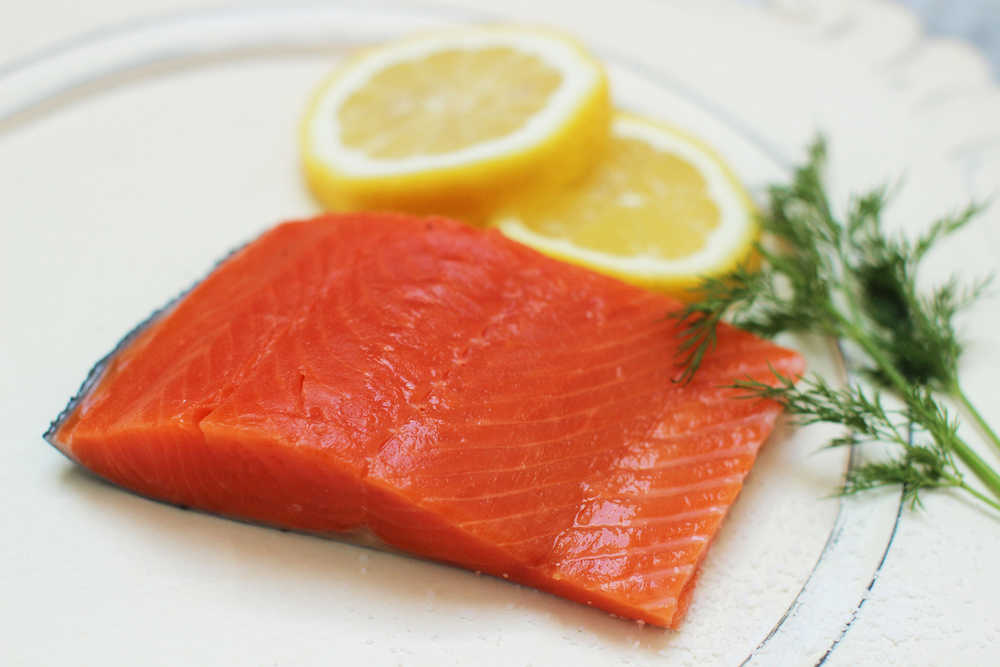Sockeye, also called red salmon, is known for its distinct, bright red flesh that retains its color even once cooked. It is prized for its firm, fatty meat, and its pronounced, yet versatile flavor. Though less buttery than king, many chefs say sockeye stars on the plate just as easily.
“It’s gorgeous. It’s beautiful,” says Anita Lo, owner and executive chef of New York’s Annisa restaurant. “And it’s meatier.”
Sockeye takes well to added butter and other fats, chefs say, as well as to flavorful seasonings.
Sockeye is eaten for both its meat and for its roe, which is used as salmon caviar for sushi. Nearly all of the country’s sockeye comes from Alaska, according to the National Oceanic and Atmospheric Administration, with the world’s largest harvest landing at Bristol Bay in the southwestern part of the state. Sockeye’s color and texture make it ideal for canning, but today more than half of the annual catch is sold fresh or frozen.
Like king salmon, the first sockeyes of the season usually come from Copper River and hit fish counters mid-May through mid-June.
Recommended preparations: Like king salmon, sockeye works with any preparation.
Often found: Most often see as lox; as the sushi salmon roe called “ikura;”at the center of the restaurant plate; and as steaks, fillets and whole fish at fish counters.
Availability: Year-round in cans, pouches and frozen; fresh from mid-May through mid-September.
Broiled Sockeye Salmon Salad With Blueberries And Sweet Potatoes
Always check salmon for bones. To do this, gently rub your hand over the flesh, going against the grain. The bones should be in a line running the length of the fish. Use tweezers or needle pliers to remove.
Start to finish: 30 minutes
Servings: 6
2 sweet potatoes, peeled and cut into 1 1/2-inch chunks
2 tablespoons olive oil
Kosher salt and ground black pepper
1 tablespoon brown sugar
1 tablespoon whole-grain mustard
1 teaspoon hot sauce
2 pounds sockeye salmon, cut into 6 pieces
3/4 cup blueberries
6 cups mixed greens
Balsamic glaze, to serve
Feta cheese, to serve
Fresh dill, to serve
Heat the oven to 425 F. Line a baking sheet with foil.
In a medium bowl, toss the sweet potatoes with the olive oil. Season with salt and pepper. Spread evenly on the prepared baking sheet and bake until tender and browned, turning occasionally, 20 to 25 minutes.
Once the sweet potatoes are cooked, remove them from the oven and heat the oven to broil. Spray another baking sheet with cooking spray.
In a small bowl, mix together the brown sugar, mustard, hot sauce and 1/2 teaspoon salt. Arrange the salmon pieces on the prepared pan and spread the brown sugar mixture over the top of each piece. Cook the salmon 4 inches from the broiler for 2 minutes, or until browned and cooked to the desired level.
Arrange 1 cup of greens on each serving plate. Top with a piece of salmon. Divide the roasted sweet potatoes among the plates, along with the blueberries. Drizzle with balsamic glaze and sprinkle with feta and fresh dill.
Nutrition information per serving: 360 calories; 150 calories from fat (42 percent of total calories); 17 g fat (3 g saturated; 0 g trans fats); 100 mg cholesterol; 19 g carbohydrate; 3 g fiber; 8 g sugar; 36 g protein; 400 mg sodium.

